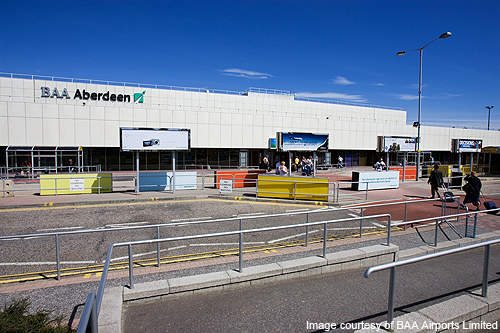Navigating Excellence: The Evolution of Aberdeen International Airport

In the northeastern corner of Scotland lies a hub of connectivity and economic vitality: Aberdeen International Airport. Nestled amidst the rugged beauty of the Scottish landscape, this airport serves as a gateway to the world for both leisure travelers and business professionals. Over the decades, Aberdeen Airport has undergone remarkable transformations, evolving from a modest airfield to a bustling aviation center that plays a pivotal role in the region’s development. Let’s embark on a journey through time and explore the rich history, current innovations, and future prospects of Aberdeen International Airport.
A Legacy Takes Flight: The Early Years
The origins of Aberdeen Airport can be traced back to the early 20th century when aviation was still in its infancy. Originally known as Dyce Aerodrome, the site served as a military airfield during World War II, playing a crucial role in defending Britain’s northern shores. After the war, as commercial aviation gained momentum, Dyce Aerodrome transitioned into a civilian airport, officially opening its doors to the public in 1955.
In its formative years, Aberdeen Airport was a modest facility, with basic infrastructure and limited passenger amenities. However, as demand for air travel grew, so did the airport’s ambitions. Throughout the 20th century, expansions and upgrades were undertaken to accommodate larger aircraft and increasing passenger numbers. By the turn of the millennium, Aberdeen Airport had firmly established itself as a key transportation hub in the United Kingdom.
Fueling Economic Growth: The Business of Aviation
Aberdeen Airport’s significance extends far beyond its role as a transport hub; it is also a catalyst for economic growth and development in the region. Situated in close proximity to the North Sea oil fields, the airport plays a vital role in supporting the offshore oil and gas industry. Thousands of workers transit through Aberdeen Airport daily, traveling to and from oil rigs and support vessels, facilitating the smooth operation of this critical sector.
Moreover, Aberdeen Airport serves as a gateway for business travelers, connecting the region to global markets. Its strategic location and well-developed infrastructure make it an attractive destination for companies seeking to establish a presence in northeastern Scotland. The airport’s cargo facilities also contribute to the local economy, facilitating the transportation of goods and supplies to domestic and international markets.
A Commitment to Excellence: Modernization and Innovation
In the 21st century, Aberdeen Airport embarked on a journey of modernization and innovation to meet the evolving needs of travelers and stakeholders. Major investment projects were undertaken to enhance infrastructure, improve passenger experience, and embrace sustainable practices. Terminal expansions, runway upgrades, and state-of-the-art technology were deployed to ensure that Aberdeen Airport remained at the forefront of aviation excellence.
One of the most notable developments in recent years has been the focus on sustainability and environmental responsibility. Aberdeen Airport has implemented various initiatives to reduce its carbon footprint, including energy-efficient lighting, waste management programs, and the adoption of alternative fuels. Additionally, efforts have been made to promote public transportation and reduce congestion around the airport, further mitigating its environmental impact.
Embracing the Digital Age: Technology and Connectivity
In an era defined by digital innovation, Aberdeen Airport has embraced technology to streamline operations and enhance the passenger experience. From self-service check-in kiosks to mobile boarding passes, travelers enjoy greater convenience and efficiency throughout their journey. Advanced security systems and biometric screening have also been implemented to ensure the safety and security of all passengers and staff.
Furthermore, Aberdeen Airport has invested in digital infrastructure to provide seamless connectivity to travelers. High-speed Wi-Fi, charging stations, and interactive wayfinding systems are just a few examples of the airport’s commitment to keeping passengers connected and informed. Moreover, digital marketing initiatives and social media engagement have been leveraged to enhance customer engagement and promote Aberdeen Airport as a premier travel destination.
Navigating the Future: Challenges and Opportunities
As Aberdeen International Airport looks to the future, it faces a myriad of challenges and opportunities. Rapid technological advancements, shifting consumer preferences, and geopolitical uncertainties are just some of the factors that will shape the aviation industry in the years to come. However, with careful planning, strategic investments, and a commitment to excellence, Aberdeen Airport is well-positioned to navigate these challenges and emerge stronger than ever.
One of the key areas of focus for the airport will be sustainable growth and development. As concerns over climate change continue to mount, there is increasing pressure on the aviation industry to reduce its environmental impact. Aberdeen Airport must continue to explore innovative solutions, such as sustainable aviation fuels and carbon offset programs, to minimize its carbon footprint while supporting economic growth and connectivity.
Additionally, Aberdeen Airport will need to adapt to evolving passenger expectations and preferences. As travelers seek more personalized and seamless experiences, the airport must embrace digital innovation and invest in technologies that enhance convenience, efficiency, and safety. Whether it’s through the use of artificial intelligence, biometrics, or augmented reality, Aberdeen Airport must remain at the forefront of technological advancements to meet the needs of modern travelers.
Conclusion
From its humble beginnings as Dyce Aerodrome to its current status as a vital transportation hub, Aberdeen International Airport has undergone remarkable transformations over the decades. Its rich history, commitment to excellence, and strategic vision have positioned it as a beacon of connectivity and economic vitality in northeastern Scotland. As Aberdeen Airport continues to evolve and innovate, it will undoubtedly play a central role in shaping the future of aviation in the region and beyond.
FAQs
Q. Where is Aberdeen International Airport located?
A. Aberdeen International Airport is situated in Dyce, a suburb of Aberdeen, Scotland, approximately 7 miles northwest of the city center.
Q. What airlines operate from Aberdeen International Airport?
A. Aberdeen Airport serves as a base for several airlines, including British Airways, EasyJet, and Loganair. Additionally, it offers flights operated by various other carriers to domestic and international destinations.
Q. What facilities are available for passengers at Aberdeen International Airport?
A. The airport offers a range of facilities and amenities for passengers, including shops, restaurants, cafes, currency exchange services, car rental desks, and lounges. There are also facilities for passengers with reduced mobility and families traveling with children.
Q. How can I get to and from Aberdeen International Airport?
A. Aberdeen Airport is easily accessible by car, taxi, and public transportation. It is well-connected to the city center and surrounding areas via road networks and public bus services. Additionally, there are designated drop-off and pick-up areas, as well as parking facilities for short-term and long-term stays.
Q. Are there any hotels near Aberdeen International Airport?
A. Yes, there are several hotels located near Aberdeen Airport, offering convenient accommodation options for travelers. Some hotels provide shuttle services to and from the airport, while others are within walking distance or a short drive away.



